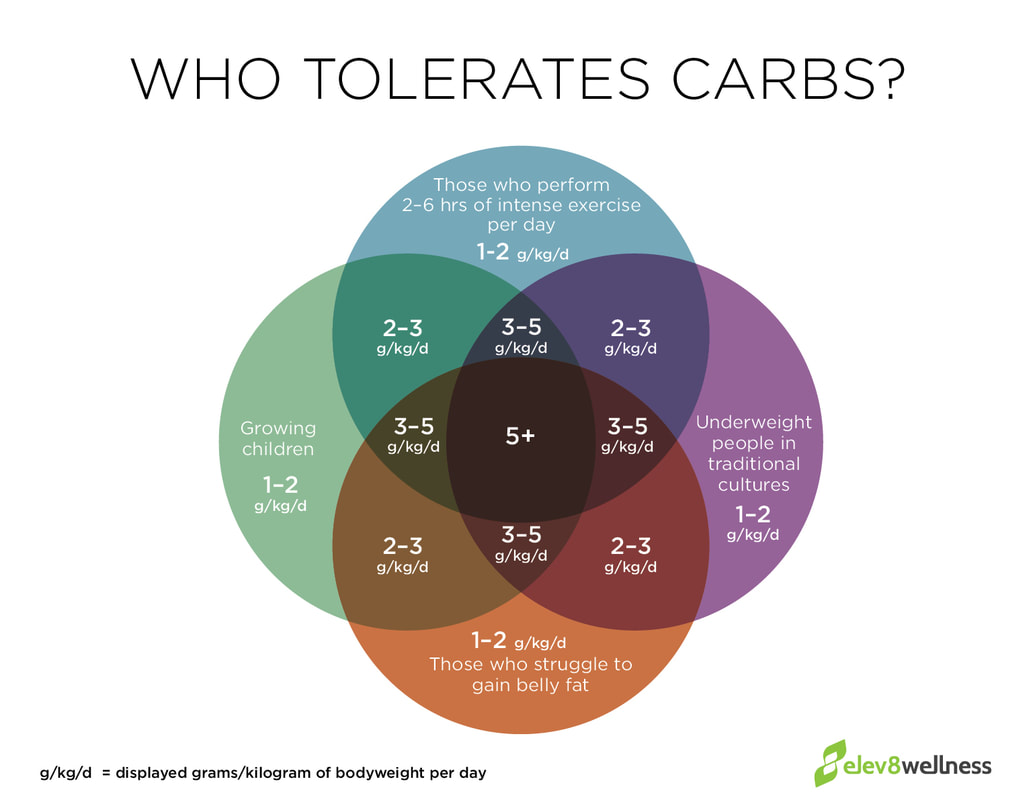|
Who Tolerates Carbs? The conclusion by ostensible authorities is murky. However, there are clear findings which point us in the right direction. The official guidelines on macronutrients is contained within the Nutrient Recommendations: Dietary Reference Intakes (DRI), which is freely available here: https://www.nap.edu/read/10490/chapter/1#ii The recommendations contained therein are accepted by the Institute of Medicine, the NIH, the National Academies and was undertaken by the National Research Council. Thus, the project to finalize these recommendations was funded and supported by the U.S. Department of Health and Human Services Office of Disease Prevention and Health Promotion, the U.S. Food and Drug Administration, the NIH, the CDC, the Institute of Medicine, the USDA, the U.S. Department of Defense and some other fairly reputable bodies. Oddly, however, there is overt disclosure of involvement on the part of Roche Vitamins Inc., Mead Johnson Nutrition Group and M&M Mars. Clearly, each of these groups’ involvement is an obvious conflict of interest in determining dispassionate purely science-driven findings. Even more odd is the admission of extreme shortcomings in these recommendations within the project’s own preface. One line reads, “although all reference values are based on data, available data were often sparse or drawn from studies with significant limitations in addressing various questions confronted by the panel and subcommittees.” Another line reads, “questions that were raised about requirements and recommended intakes could not be answered satisfactorily.” Nonetheless, although all of the aforementioned might lead an educated reader to expect outrageously high carbohydrate recommendations (as was the case with the food pyramid, Western breakfast culture, etc.) the conclusions are quite the contrary. If anything, the National Research Council really went out of its way to take into account as many considerations as possible. Chapter 6 Dietary Carbohydrates: Sugars and Starches is a treasure trove of citations from disparate research groups which drills down into known biological mechanisms. The authors admit to incredible layers of complexity far beyond even Glycemic Index ratings, chemical structure and World Health Organization’s attempts at answering carbohydrate-apropos questions. That is, any recommendation is only as good as it takes into account every other factor. Change one variable elsewhere (e.g. - the protein intake, an 18-hour fasted status, body mass, etc.); and the range of recommendations must consequently change. Most intriguing is that page 275, Clinical Effects of Inadequate Intake, is very clear about the sum total body of scientific knowledge on the subject: “the lower limit of dietary carbohydrate compatible with life apparently is zero.” The authors went on to describe how every attempt to confound this biological fact has come up entirely and unequivocally empty-handed. Humans require no exogenous carbohydrates whatsoever. ZERO. "the lower limit of dietary carbohydrate compatible with life apparently is zero" - The National Research Council The chapter does go on to explore what level of carbohydrate may be required in the absence or inadequacy of dietary protein or fats. However, even in clinical research on starvation, the human body is incredibly resilient at meeting all of its energy needs without much downside at all. Obviously, starvation cannot be continued for periods longer than a few weeks; and this doesn’t answer the question about optimal human performance, optimal athletic performance or tolerance. The authors do attempt to peg recommendations based on the energy demands of a theoretical male and female of various ages, zeroing in on about 100 grams per day for most ages, allotting for up to a possible approximate 200 grams per day for pregnant or nursing mothers. However, on page 281, they also invoke the Fomon research, which showed that EVEN WITH INFANTS THERE IS NO DIFFERENCE IN RATE OF GROWTH OR BRAIN DEVELOPMENT WITH A DIET COMPRISED OF 32% VERSUS 64% CARBOHYDRATES. The first conclusions are obvious: it is easy to state emphatically that carbohydrate need is zero; it is very difficult to emphatically say what additional intake of carbohydrate serves ANY benefit. Consequently, we are increasingly backed into a corner wherein the question moves away from “how many grams of carbohydrates should a human have?” to “how many grams of carbohydrates can someone get away with?” Or, who can tolerate carbs? Really. Who CAN tolerate carbs? Since even the people most tolerant of carbs will subject themselves to possible long-term consequences from the unavoidable inflammatory responses inherent within carbohydrate consumption, this question can’t well be answered with finality for the long-term. But we can look at the near-term. In the near-term, who can get away with carbs, and by what degree? The answer may be best answered first by clarifying what tolerance is exactly. Glucose tolerance is the ability to readily dispense of a rise in blood sugar. This comes down to hormone balance and systemic status of glucose transporters, insulin receptors, pancreatic, hepatic, adrenal and renal function. We can test it at each level or the gestalt. So we can answer this question definitively in any individual. People merely need to test blood sugar prior to eating, test again after spiking after eating, and find that they return to pre-meal baseline within 30 minutes after spiking. That would indicate that this particular individual tolerates well that bolus of that carbohydrate under those circumstances. But we could draw the conclusions no further. Just as the authors of the DRI paper concluded, every variable affects everything else. If the amount of dietary fat or protein for that person varies the very next day, the tolerance would be different. If the activity level varies, the tolerance would be different. And so on. In my experience with glucose testing on clients and with my own readings over the past 13 years, the Venn Diagram above is far too forgiving (but given the question of tolerance I’m erring on the high side). Even a heavily-muscled, extremely lean, young, highly-active male or female with ectomorphic tendencies and great genetics who is aiming to gain size will eventually run into body fat gains and increased risk of all-cause mortality not long after 3-4 grams per kg bodyweight per day. Most people can't tolerate 1g/kg/d. It is true that there are healthy and long-lived cultures who have a higher percent of carbohydrate intake. But they are playing by different rules. We can cross-reference the Tsimane and Okinawans who both tolerate and even thrive with a 70% dietary carbohydrate intake. Nonetheless, their total food intake is so minimal as to fall within or under the 1-2 g/kg/d guideline, and in both cultures there is nonexistent processed food, nonexistent sedentary behavior and nonexistent obesity. So they have the cards stacked in their favor to begin with. In the industrialized Western World, we have an end-spectrum example of stratospheric carbohydrate tolerance: elite ultra-endurance athletes. In the Tour de France, for example, cyclists gain no body fat during competition. They may even lose up to 10lbs while eating as much food as they can fit into their bodies. We do know that the act of physical exercise inhibits insulin production and its release; and we know that Tour cyclists are dispensing hundreds of thousands of milligrams of glucose per hour. Their average daily carbohydrate consumption is about 850g (https://www.ncbi.nlm.nih.gov/pubmed/9506803). And the average weight of a Tour cyclist is 68kg. Therefore, at least in the near-term we know of a far-end-of-spectrum tolerance of 12.5g/kg/d or more. Keep in mind, competitive ultra-endurance activity has been clocked at an average of 10,000 calories per day on the Total Energy Expenditure (TEE) measurements (https://www.ncbi.nlm.nih.gov/pmc/articles/PMC5292109/), with a high of around 14,000 calories or more expended by some athletes. Their activity level is so astronomical that in theory some could tolerate (if the gut could handle it) over 3,000 grams of carbohydrates per day. But that is the absolute upper limit only during competition for the most elite of ultra-endurance athletes. Ergo, we are left with transient guidelines based first on the body composition tendency of the individual (which will dictate metabolic rate, and distribution of energy to prevalent tissues), second on the sufficiency of other macronutrients, and lastly on excesses incurred by activity level. This is also why there are numerous athletes who can tolerate, at least in the near-term, higher carbohydrate consumption. They tend toward lower body fat percentage than that of the average populace. They generally carry an absolute amount of lean tissue that is far greater than that of the average populace. They may even be attempting to grow more tissue. Their eating habits may even more closely reflect that of traditional cultures (that is, they must be more intentional in their inclusion of micronutrient sufficiency and nutrient dense foods). And their TEE is multiples of that of the average populace. Summary: Who must have carbs? - The entirety of science says no one Who should have carbs? - Maybe infants and nursing moms * I do not include athletes in this heading because there is no finality on the discussion with respect to exogenous carbohydrate consumption and athletic performance. Though one can reason that there ought to be a need, based on certain understandings about citric acid cycle and muscle fiber type, rigorous research has failed to bear this out even if we narrow our definition of “should” to the possible immediate benefit in training or competition. Chapter 6 contains breadth on this topic. The NRC notes more than once that dietary consumption of protein can suffice in this regard. Also, there exist fairly conclusive findings which indicate there is no downside in athletic performance with extreme carbohydrate restriction (http://www.elev8wellness.com/wellblog_best_nutrition_training_coaching_experts/-please-stop-the-carbs-because-science) even for intense activity among advanced athletes. To be fair, it seems that people must first transition through a period (3-42 days) of fuel-preference alteration before they can enjoy uninhibited athleticism with carbohydrate intake suppression. Who can tolerate some carbs? - Anyone who is trying to grow tissue - Anyone who is very lean - Several traditional cultures Who can tolerate some more carbs? - Energy expenditure machines Among those who can tolerate carbs, how much at maximum can they get away with? - According to the National Research Council, 28g/d (for infants) up to around 100-130g/d for most youths and adults, and around 200g/d for pregnant or nursing mothers, depending on other variables - It seems about 1-2g/kg/d per categorical variable that is in your favor - Infinite theoretical endpoint with commensurate or supra-commensurate energy expenditure (keep in mind that the endpoint example provided above had athletes consuming an average of about 850g of carbs, which is 3,400 kCal, while their average TEE was about 10,000 kCal; so they are far more than exhausting their blood sugar spike from all food {not just carbs}, any amino acids, fatty acids and triglycerides, and ketones in the blood, AND their muscle and liver glycogen - in the average populace this would be akin to a 5-7 day outright fast while still somewhat active)
0 Comments
Your comment will be posted after it is approved.
Leave a Reply. |
Elev8 Wellness
|
LIVE. AWESOME.We offer the highest quality in personal fitness, nutrition, and mindset coaching, helping you achieve your fitness, health, wellness and performance goals no matter the obstacle. With virtual online training and private, in-studio training we make it easier to reach your wellness goals safely.
No more can't. No more not good enough. If you compete in a sport, let your mind no longer hold you back from being the greatest. If you don't, let your mind no longer hold you back from being the best version of you that you can be. Sign-up for a Tour Covid Screen Waiver Elev8 Waiver Become an Elev8 Instructor Space Rental |
6244 lyndale ave. s., minneapolis, mn 55423
|
© 2021 Elev8 Wellness LLC. All Rights Reserved. site map | contribute | SITE BY Sproute Creative



 RSS Feed
RSS Feed
